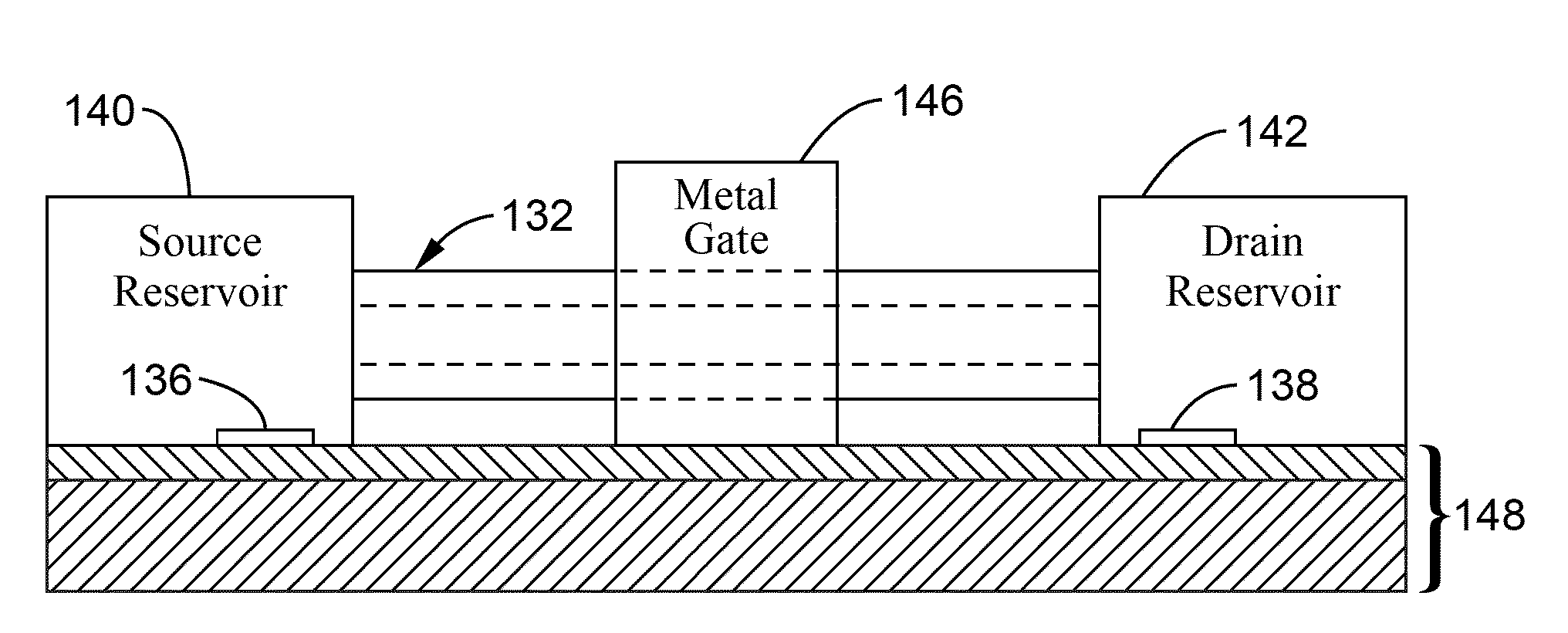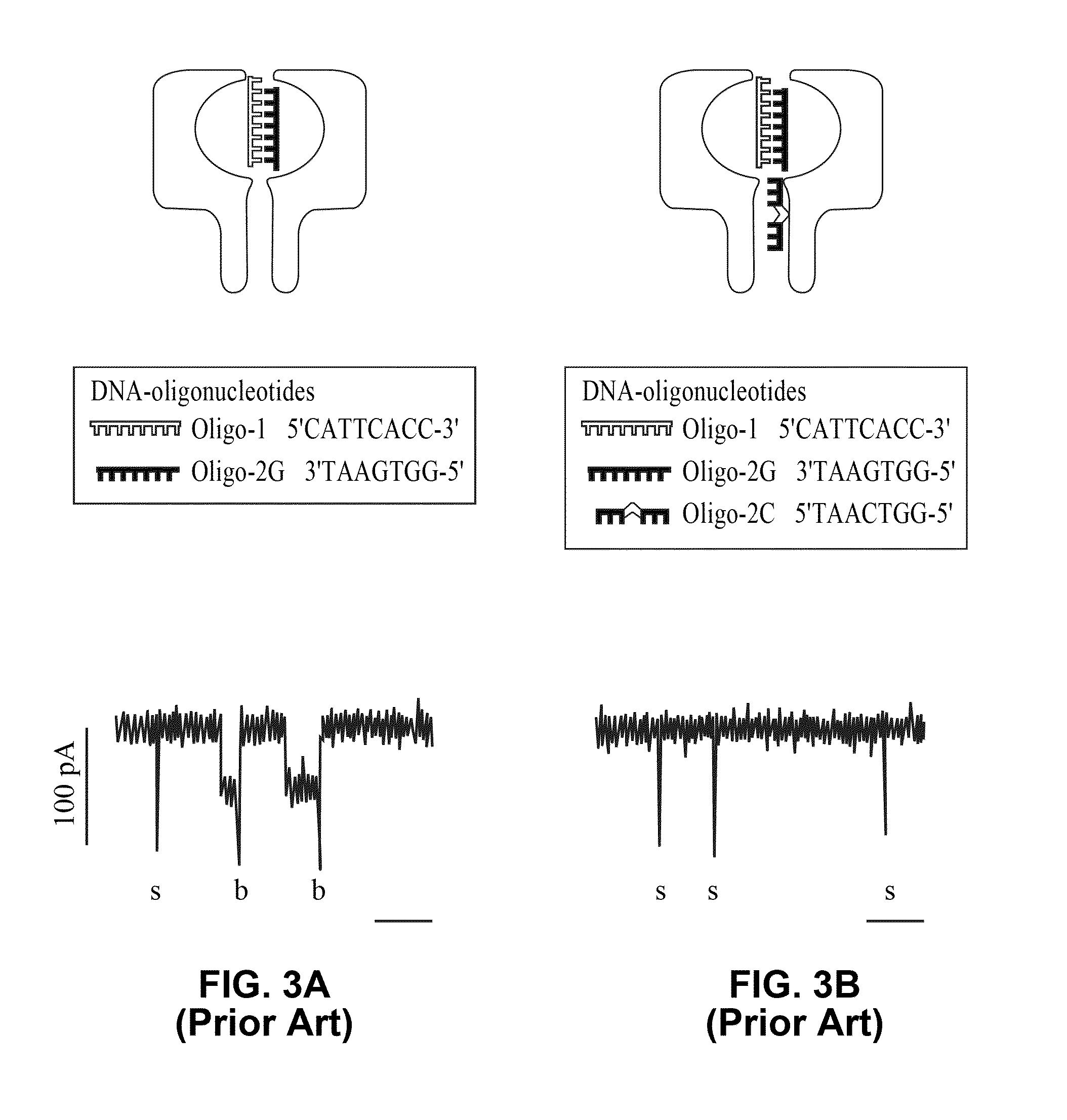Fluidic nanotubes and devices
a technology of fluidic nanotubes and nanotubes, which is applied in the field of fluidic devices, can solve the problems of general hydrophobicity of nanotubes and may not be suitable for fluidic applications without modification, and achieve the effects of reducing the size, weight and cost of sensors and sensor arrays, and increasing spatial and temporal resolution and accuracy
- Summary
- Abstract
- Description
- Claims
- Application Information
AI Technical Summary
Benefits of technology
Problems solved by technology
Method used
Image
Examples
example 1
[0128]The nanowire cores employed in the present invention can be formed in any conventional manner. For example, arrays of zinc oxide (ZnO) nanowires were grown on a substrate material, such as (110) sapphire wafers, preferably using a vapor deposition process. These ZnO nanowire arrays were placed inside a reaction tube (i.e. MOCVD reaction tube) for GaN chemical vapor deposition. Trimethylgallium and ammonia were used as precursors and fed into the system with argon or nitrogen carrier gas. The deposition temperature was preferably set at 600° C. to 700° C.
[0129]After the GaN deposition, the samples were treated in a hydrogen atmosphere at elevated temperature, such as 600° C. with 10% H2 in argon, for removing the ZnO nanowire templates. It should be appreciated that other methods and materials may be utilized (although in some instances less preferably) for forming the nanowires, covering the nanowires with the nanotube material, and for sacrificially removing the nanowire mate...
example 2
[0152]FIG. 18A illustrates silicon nanowire arrays which were prepared using chemical vapor deposition (CVD) epitaxial growth employing silicon tetrachloride (SiCl4, Aldrich, 99.99%) as the silicon source. Hydrogen (10% balanced by argon) was used to reduce SiCl4 at high temperature (900-950° C.). Gold (Au) thin film was coated on Si (111) substrates 30 to initiate the growth of silicon nanowires 32 via the vapor-liquid-solid growth mechanism. The gold remains as caps 34 on the Si nanowires. This approach to growing Si nanowires was developed and is utilized by the inventors for the synthesis of vertical Si / SiGe superlattice nanowire arrays. The silicon nanowire array samples were heated, such as loaded into a tube furnace and heated at 800-1000° C. for one hour under the continuous flow of pure oxygen (O2).
[0153]FIG. 18B depicts the nanowires 32 after being uniformly oxidized to provide SiO2 sheaths 36 with continuous silicon cores inside. During oxidation, the nanowire tips 34 are...
example 3
[0160]FIG. 19A-19D are images of nanotube formation according to the invention, registered as scanning electron micrographs (SEM). A silicon nanowire array is shown in FIG. 19A, with the Si nanowires vertically orientated to form a substantially perfect array. Typical sizes of the silicon nanowires are 50-200 nm, and the length is around 8 μm. On the top of each nanowire can be seen a bright gold tip indicative of the vapor-liquid-solid growth.
[0161]FIG. 19B illustrates the nanotubes after parylene deposition, SiO2 cap removal, and the etching of the silicon cores, wherein a silica nanotube array embedded in parylene membrane is formed. The pores can be readily seen on the polymer surface. The bright spots on the image corresponding to the gold nanoparticle tips, which nearly take the shape of half spheres. The membrane has a relatively flat surface. The inset within FIG. 19B depicts high magnification of two silica nanotubes embedded in the parylene membrane, clearly showing the ho...
PUM
| Property | Measurement | Unit |
|---|---|---|
| pore size | aaaaa | aaaaa |
| ionic current | aaaaa | aaaaa |
| current | aaaaa | aaaaa |
Abstract
Description
Claims
Application Information
 Login to View More
Login to View More - R&D
- Intellectual Property
- Life Sciences
- Materials
- Tech Scout
- Unparalleled Data Quality
- Higher Quality Content
- 60% Fewer Hallucinations
Browse by: Latest US Patents, China's latest patents, Technical Efficacy Thesaurus, Application Domain, Technology Topic, Popular Technical Reports.
© 2025 PatSnap. All rights reserved.Legal|Privacy policy|Modern Slavery Act Transparency Statement|Sitemap|About US| Contact US: help@patsnap.com



